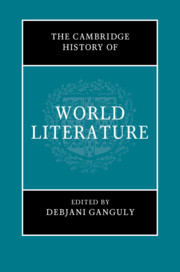Book contents
- The Cambridge History of World Literature
- The Cambridge History of World Literature
- Copyright page
- Contents
- Figures
- Contributors
- Acknowledgements
- Introduction
- Part I Genealogies
- Part II Thinking the World
- Part III Transregional Worlding
- Part IV Cartographic Shifts
- Part V World Literature and Translation
- Part VI Poetics, Genre, Intermediality
- Part VII Scales, Polysystems, Canons
- Part VIII Modes of Reading and Circulation
- 40 Transregional Critique and the Challenge of Comparison: Between Latin America and China
- 41 Reading World Literature through the Postcolonial and Diasporic Lens
- 42 The Indian Republic, Reading Publics, and World Literary Catalogues
- 43 The Cultural Industry and Digital World Making
- Part IX The Worldly and the Planetary
- Index
- References
42 - The Indian Republic, Reading Publics, and World Literary Catalogues
from Part VIII - Modes of Reading and Circulation
Published online by Cambridge University Press: 17 August 2021
- The Cambridge History of World Literature
- The Cambridge History of World Literature
- Copyright page
- Contents
- Figures
- Contributors
- Acknowledgements
- Introduction
- Part I Genealogies
- Part II Thinking the World
- Part III Transregional Worlding
- Part IV Cartographic Shifts
- Part V World Literature and Translation
- Part VI Poetics, Genre, Intermediality
- Part VII Scales, Polysystems, Canons
- Part VIII Modes of Reading and Circulation
- 40 Transregional Critique and the Challenge of Comparison: Between Latin America and China
- 41 Reading World Literature through the Postcolonial and Diasporic Lens
- 42 The Indian Republic, Reading Publics, and World Literary Catalogues
- 43 The Cultural Industry and Digital World Making
- Part IX The Worldly and the Planetary
- Index
- References
Summary
The main aim of this chapter is to articulate the relationship between literary catalogs and their creation of readerships, especially when the said relationship is mediated by the state. I propose that the catalogs of national, and by extension world literature become politically and ideology inflected, sometimes through facilitation, other times through obstruction by the state and its ancillaries. I further argue in this chapter that through differentiations of the native and the foreign, the indigenous and the migrant—often propagated through majoritarian myths of national origins—the state functions to privilege certain languages and literatures over others by claims of ownership of certain literary traditions and rejection of others. In addition, the chapter also provide examples of ways in which populist conflations of the indigenous with the original are offered resistance. To this end, the chapter I want to draw attention to three “bibliographic” moments in the changing pact with books of the Indian reading publics: late nineteenth, mid-twentieth, and early twenty-first centuries.
Keywords
- Type
- Chapter
- Information
- The Cambridge History of World Literature , pp. 821 - 841Publisher: Cambridge University PressPrint publication year: 2021



